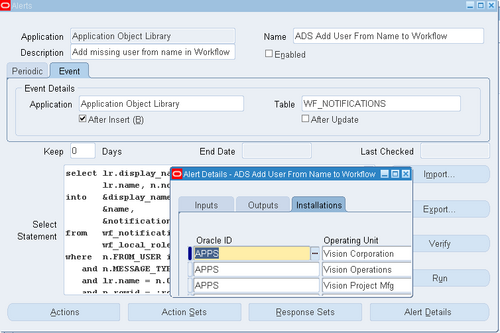To create a periodic alert, you perform the following tasks in the order listed:
- Define your periodic alert and specify its frequency.
- Specify the details for your alert.
- Define actions for your alert.
- Create action sets containing the actions you want your alert to perform.
Before you define a periodic alert, make sure you do the following:
• Configure the Workflow Notification Mailer to send and receive e-mail messages according to your alert requirements.
• Specify Oracle Alert options to configure how Oracle Alert checks alerts and handles alert messages.
Enter a SQL Select statement that retrieves all the data your alert needs to perform the actions you plan to define.
Your periodic alert Select statement must include an INTO clause that contains one output for each column selected by your Select statement. Identify any inputs with a colon before the name, for example, :INPUT_NAME. Identify any outputs with an ampersand (&) before the name, for example, &OUTPUT_NAME. Do not use set operators in your Select statement.
Tip: If you want to use an input value in an action for this alert, select the input into an output. Then you can use the output when you define actions for this alert.
When selecting number columns, Oracle Alert uses the number formats defined in your database. Optionally, you can format your number outputs as real numbers by specifying a SQL*Plus format mask in your Select statement. For each number output, simply add a pound sign (#) and format mask to your output name. For example, if you select purchase price into the output &PRICE, add “#9999.99” after &PRICE for Oracle Alert to display the value to two
decimal places. Your number output looks like: &PRICE#9999.99. Here is an example of a periodic alert Select statement that looks for users who have not changed their passwords within the number of days specified by the value in :THRESHOLD_DAYS.:
SELECT user_name,
password_date,
:THRESHOLD_DAYS
INTO &USER,
&LASTDATE,
&NUMDAYS
FROM fnd_user
WHERE sysdate = NVL(password_date,
sysdate) + :THRESHOLD_DAYS
ORDER BY user_name
Note: Although Oracle Alert does not support PL/SQL statements as the alert SQL statement definition, you can create a PL/SQL packaged function that contains PL/SQL logic and enter a SQL Select statement that calls that packaged function. For example, you can enter a SQL Select statement that looks like:
SELECT package1.function1(:INPUT1, column1)
INTO &OUTPUT1
FROM table1
In this example, package1 is the name of the PL/SQL package and function1 is the name of user-defined PL/SQL function stored in the package.


Recent Comments